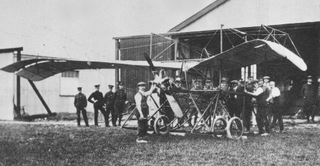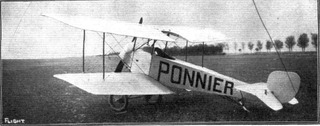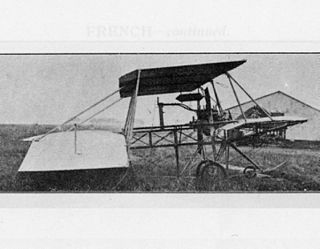
John William Dunne was a British soldier, aeronautical engineer and philosopher. As a young man he fought in the Second Boer War, before becoming a pioneering aeroplane designer in the early years of the 20th century. Dunne worked on automatically stable aircraft, many of which were of tailless swept wing design, to achieve the first certified stable aircraft. He later developed a new approach to dry fly fishing before turning to speculative philosophy, where he achieved some prominence and literary influence through his "serialism" theory on the nature of time and consciousness, explained in his book An Experiment with Time.

The Boxkite was the first aircraft produced by the British and Colonial Aeroplane Company. A pusher biplane based on the successful Farman III, it was one of the first aircraft types to be built in quantity. As the type was used by Bristol for instruction purposes at their flying schools at Larkhill and Brooklands many early British aviators learned to fly in a Boxkite. Four were purchased in 1911 by the War Office and examples were sold to Russia and Australia. It continued to be used for training purposes until after the outbreak of the First World War.

The Bristol Scout was a single-seat rotary-engined biplane originally designed as a racing aircraft. Like similar fast, light aircraft of the period it was used by the RNAS and the RFC as a "scout", or fast reconnaissance type. It was one of the first single-seaters to be used as a fighter aircraft, although it was not possible to fit it with an effective forward-firing armament until the first British-designed gun synchronizers became available later in 1916, by which time the Scout was obsolescent. Single-seat fighters continued to be called "scouts" in British usage into the early 1920s.

The Avro Type E, Type 500, and Type 502 made up a family of early British military aircraft, regarded by Alliott Verdon Roe as his firm's first truly successful design. It was a forerunner of the Avro 504, one of the outstanding aircraft of the First World War.
The Dunne D.1, was an experimental tailless aircraft built in the UK in 1907. It comprised a main unit which could be flown as a glider, to which a chassis unit with power train could be added. The glider achieved a short flight in 1907. The D.1 was later rebuilt as the powered D.4, which achieved short hops in 1908.

The Dunne D.5 was a British experimental aircraft built in 1910. A tailless swept-wing biplane, it was designed by J. W. Dunne and built by Short Brothers at Leysdown for his company, the Blair Atholl Aeroplane Syndicate Ltd. Like its military predecessors it was driven by twin pusher propellers, but it had a considerably more powerful engine.

The Handley Page Type G was a two-seat British biplane, designed by Handley Page that first flew in 1913. Only one was built.
The Sopwith Three-seater was a British aircraft designed and built prior to the start of the First World War. One of the first aircraft built by the Sopwith Aviation Company, it was operated by both the Royal Naval Air Service (RNAS) and the Royal Flying Corps (RFC), being used briefly over Belgium by the RNAS following the start of the War.

The Royal Aircraft Factory R.E.1 was an experimental two-seat single-engined biplane from before World War I, intended to develop reconnaissance aircraft.

The Dunne D.7 was one of J. W. Dunne's swept wing tailless aircraft designed to have automatic stability, first flying in 1911. It was a single seat, single engined pusher monoplane developed from the unsuccessful D.6.

The Short S.27 and its derivative, the Short Improved S.27, were a series of early British aircraft built by Short Brothers. They were used by the Admiralty and Naval Wing of the Royal Flying Corps for training the Royal Navy's first pilots as well as for early naval aviation experiments. An Improved S.27 was used by C.R. Samson to make the first successful take-off from a moving ship on 9 May 1912.
The Perry Beadle T.1 was a single-seat, single engine biplane built and flown in the United Kingdom in 1913. In 1914 it flew with a more powerful engine and other modifications as the Perry Beadle T.2, which was acquired by the Royal Navy Air Service at the outbreak of World War I.

The Nieuport II was a mid-wing monoplane racing or sport aircraft built by the Société Anonyme des Établissements Nieuport between 1910 and 1914 and was noted for its high performance using a small twin-cylinder engine, and winning many races, primarily in France before being used as a trainer during World War I by French flying schools.

The Short S.36 was a British two-seat tractor biplane, built by Short Brothers for Francis McClean in 1911. It was later developed into the Short S.41 and Short S.45, which were the first of a long series of similar aircraft built for the RNAS and RFC.

The Ponnier L.1 was an early French biplane single seat scout, built just before World War I. It did not reach production.

The Ponnier D.III was a French monoplane racing aircraft, designed to compete in the 1913 Gordon Bennett Trophy race. It finished a close second.
The Caudron Type B was a 1911 development of the earliest Caudron type, the Caudron Type A, with a nacelle style fuselage and more powerful engine. Initially an equal span biplane, it was modified into a sesquiplane.
The Euler Hydro-triplane was an unusual pusher configuration amphibious triplane flying boat, built in Germany in 1913.

The Dunne-Huntington triplane, sometimes referred to as a biplane, was a pioneer aircraft designed by J. W. Dunne and built by A. K. Huntington. It was of unusual staggered triple-tandem configuration and an early example of an inherently stable aeroplane, flying regularly between 1910 and 1914.

The Nieuport-Delage NiD 940 was a French, tailless, pusher configuration touring aircraft first flown in 1934. It suffered from longitudinal instabilities and despite modifications and a more powerful engine, it did not receive its Certificate of Airworthiness.

















